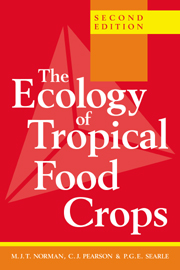16 - Sweet potato (Ipomoea batatas)
Published online by Cambridge University Press: 05 June 2012
Summary
Taxonomy
The sweet potato (Ipomoea batatas (L.) Lam.), a perennial which is cultivated as an annual, is a member of the Convolvulaceae. There are about 500 wild species of Ipomoea, but the sweet potato is not known in the wild state. Yen (1976) and Austin (1978, 1988) have tackled the debated taxonomy of the genus. The revision of Austin (1978) recognised 11 species in the section Batatas, which includes the sweet potato. Subsequently three species have been added and one removed (Jarret, Gawel & Whittemore, 1992). The closest wild relatives of the sweet potato appear to be I. trifida and I. tabascana.
Morphological variation is treated exhaustively by Yen (1974). Economically important characteristics used in intra-specific classification include tuber shape and flesh colour. Yen recognises six basic shapes and three flesh-colour groups: white-yellow, pink-orange, and shades of purple.
Origin, evolution and dispersal
The sweet potato is of Central or tropical South American origin. Nishiyama (1971) and Martin & Jones (1972) suggest Mexico as the centre of diversity of the Batatas section of Ipomoea. However, the earliest archaeological record of cultivated sweet potatoes is from the Peruvian coast (4500 bp) and the crop has not been recovered from any of the ancient Mexican sites such as Tehuacan. The fact that the earliest finds are from coastal Peru is a consequence of the area's climatic aridity, favouring the preservation of crop remains: the area cannot be the centre of domestication since no wild prototypes are found there.
- Type
- Chapter
- Information
- The Ecology of Tropical Food Crops , pp. 291 - 304Publisher: Cambridge University PressPrint publication year: 1995



